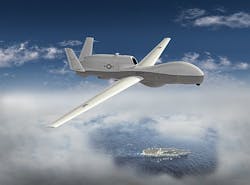PATUXENT RIVER NAS, Md. – Signals intelligence (SIGINT) experts at Northrop Grumman Corp. are preparing to upgrade the U.S. Navy MQ-4C Triton long-range unmanned aerial vehicle (UAV) with SIGINT capability to match that of the Navy's EP-3 manned SIGINT aircraft.
Officials of the Naval Air Systems Command at Patuxent River Naval Air Station, Md., announced a $19.3 million order Wednesday to the Northrop Grumman Aerospace Systems segment in San Diego to buy unique materials necessary to integrate the Triton integrated functional capability (IFC) 4.0.
The MQ-4C Triton, built by Northrop Grumman Aerospace, is a maritime patrol version of the Northrop Grumman RQ-4 Global Hawk long-range reconnaissance UAV. The Triton provides real-time intelligence, surveillance, and reconnaissance missions (ISR) over vast ocean and coastal regions.
The unmanned aircraft is designed to perform continuous maritime surveillance, conduct search and rescue missions, and to complement the Boeing P-8 Poseidon maritime patrol aircraft.
Compared with the Global Hawk, the Triton has a reinforced airframe and wing, de-icing systems, and lightning protection to enable it to descend through cloud layers to gain a closer view of ships and other targets at sea. It can track ships over time by gathering information on their speed, location, and type.
The Triton IFC 4.0 project seeks to upgrade the Triton UAV with multi-intelligence capabilities that include SIGINT, such that Triton IFC 4.0 UAVs could replace the Navy's fleet of EP-3 aircraft.
The EP-3 aircraft are based on the Lockheed Martin P-3 Orion four-engine turboprop airframe, and are scheduled to be retired in 2021. Much of the EP-3's mission and electronic equipment is secret and is conducted in high-threat areas where long-range standoff is necessary.
The Triton program is installing a SIGINT sensor payload with components from Boeing Argon ST in Fairfax, Va., and Sierra Nevada Corp. in Sparks, Nev. Navy plans call for delivering the IFC 4 version of the Triton UAV in 2021 to coincide with the Navy’s retirement of the EP-3.
On this contract Northrop Grumman will do the work in San Diego, Menlo Park, Placentia, and San Clemente, Calif.; Waco, Texas; New Town, N.D.; West Chester, Ohio; Middletown, Wis.; Malabar Fla.; Medford, N.Y.; Bridgeport, W.Va.; and various locations in the continental U.S., and should be finished by July 2020.
For more information contact Northrop Grumman Aerospace online at www.northropgrumman.com, or Naval Air Systems Command at www.navair.navy.mil.
Ready to make a purchase? Search the Military & Aerospace Electronics Buyer's Guide for companies, new products, press releases, and videos

